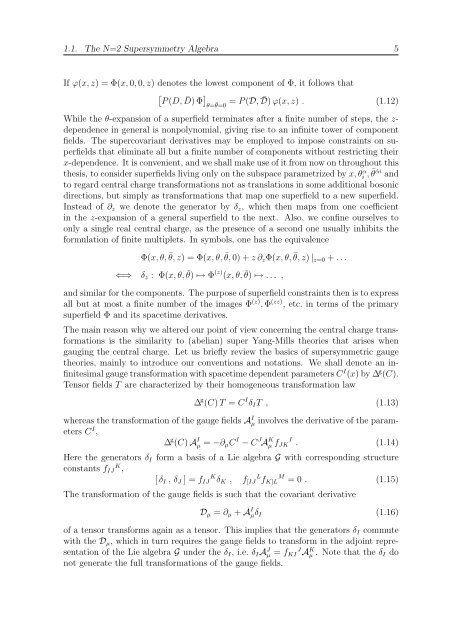N=2 Supersymmetric Gauge Theories with Nonpolynomial Interactions
N=2 Supersymmetric Gauge Theories with Nonpolynomial Interactions
N=2 Supersymmetric Gauge Theories with Nonpolynomial Interactions
Create successful ePaper yourself
Turn your PDF publications into a flip-book with our unique Google optimized e-Paper software.
1.1. The <strong>N=2</strong> Supersymmetry Algebra 5<br />
If ϕ(x, z) = Φ(x, 0, 0, z) denotes the lowest component of Φ, it follows that<br />
P (D, ¯ D) Φ <br />
θ= ¯ θ=0 = P (D, ¯ D) ϕ(x, z) . (1.12)<br />
While the θ-expansion of a superfield terminates after a finite number of steps, the zdependence<br />
in general is nonpolynomial, giving rise to an infinite tower of component<br />
fields. The supercovariant derivatives may be employed to impose constraints on superfields<br />
that eliminate all but a finite number of components <strong>with</strong>out restricting their<br />
x-dependence. It is convenient, and we shall make use of it from now on throughout this<br />
thesis, to consider superfields living only on the subspace parametrized by x, θ α i , ¯ θ ˙αi and<br />
to regard central charge transformations not as translations in some additional bosonic<br />
directions, but simply as transformations that map one superfield to a new superfield.<br />
Instead of ∂z we denote the generator by δz, which then maps from one coefficient<br />
in the z-expansion of a general superfield to the next. Also, we confine ourselves to<br />
only a single real central charge, as the presence of a second one usually inhibits the<br />
formulation of finite multiplets. In symbols, one has the equivalence<br />
Φ(x, θ, ¯ θ, z) = Φ(x, θ, ¯ θ, 0) + z ∂zΦ(x, θ, ¯ θ, z) |z=0 + . . .<br />
⇐⇒ δz : Φ(x, θ, ¯ θ) ↦→ Φ (z) (x, θ, ¯ θ) ↦→ . . . ,<br />
and similar for the components. The purpose of superfield constraints then is to express<br />
all but at most a finite number of the images Φ (z) , Φ (zz) , etc. in terms of the primary<br />
superfield Φ and its spacetime derivatives.<br />
The main reason why we altered our point of view concerning the central charge transformations<br />
is the similarity to (abelian) super Yang-Mills theories that arises when<br />
gauging the central charge. Let us briefly review the basics of supersymmetric gauge<br />
theories, mainly to introduce our conventions and notations. We shall denote an infinitesimal<br />
gauge transformation <strong>with</strong> spacetime dependent parameters C I (x) by ∆ g (C).<br />
Tensor fields T are characterized by their homogeneous transformation law<br />
∆ g (C) T = C I δIT , (1.13)<br />
whereas the transformation of the gauge fields A I µ involves the derivative of the parameters<br />
C I ,<br />
∆ g (C) A I µ = −∂µC I − C J A K µ fJK I . (1.14)<br />
Here the generators δI form a basis of a Lie algebra G <strong>with</strong> corresponding structure<br />
constants fIJ K ,<br />
[ δI , δJ ] = fIJ K δK , f[IJ L fK]L M = 0 . (1.15)<br />
The transformation of the gauge fields is such that the covariant derivative<br />
Dµ = ∂µ + A I µδI<br />
(1.16)<br />
of a tensor transforms again as a tensor. This implies that the generators δI commute<br />
<strong>with</strong> the Dµ, which in turn requires the gauge fields to transform in the adjoint representation<br />
of the Lie algebra G under the δI, i.e. δIA J µ = fKI J A K µ . Note that the δI do<br />
not generate the full transformations of the gauge fields.

















